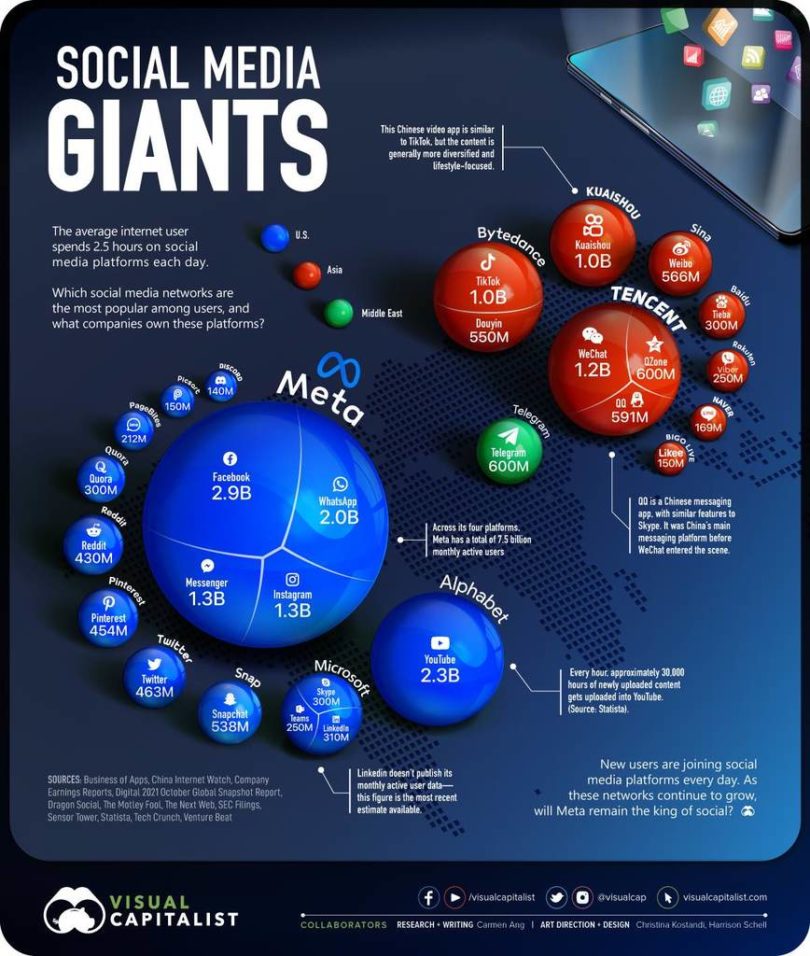We’ve seen quite a consolidation of social platform usage over the last few years but this infographic from Visual Capitalist is still surprising. As you can see, the current social media landscape is dominated by one player and two lesser giants, with everyone else trailing far behind.
As you might have guessed, Meta (formerly Facebook) has more than three times the users than Alphabet (YouTube) or Tencent, coming in at around 7.5 billion monthly users. No other company is even close.
Some interesting data points from the graphic – Users spend around 2.5 hours on social media every day. And every hour 38,000 hours of video is uploaded to YouTube, which is a staggering amount. No matter how large your view count is, you’re still a drop in the YouTube bucket.
The Social Lifespan
It wasn’t that long ago that 50 million active monthly users was the signal that a platform had arrived. Now you need around 150 million just to be classified as a minor player on the world stage. Still, social platforms do have a lifespan, which seems to be closely related with the age of its users. Every generation has its own favorite, and as those users get older, they spend less time on social in general or even abandon the platform.
We’ve certainly seen that with previous platforms like Friendster and Myspace, but we’re now starting to see some of the giants like Facebook, Instagram, Twitter and Skype level out. Usually this is a case of a newer platform taking marketshare away, but sometimes it’s just a result of user fatigue.
While TikTok is the new hot and shiny platform that has captivated teens worldwide, one has to wonder what’s going to happen as they begin to age and have busier lives. Also, many governments are now threatening the platform with outside control or outright banishment as a result on the negative effects it’s supposedly having on youth psyche (which is fragile as is without any outside help).
Next year should be a pivotal year in the social media landscape, so expect changes in the this chart when we look back at the end.
The World’s Most Popular Social Networks, and Who Owns Them
Currently, there are over 4.5 billion people around the world who use some form of social media—about 57% of the global population.
Yet, while social media’s audience is widespread and diverse, just a handful of companies control a majority of the world’s most popular social media platforms. Meta, the tech giant formerly known as Facebook, owns four of the five most widely used platforms.
This graphic highlights the biggest social networks across the globe, measured by their monthly active users (MAUs).
Note: We’ll be using terms like “social network” and “social platform” interchangeably to refer to various messaging, video, and image-sharing platforms that have social attributes built in.
Top Social Platforms by Monthly Active Users
To measure each platform’s MAUs, we dug into various sources, including the most recent company SEC filings, and quarterly earnings reports.
A majority of Meta’s user base comes from its most popular platform, Facebook—the social media giant currently has around 2.9 billion MAUs worldwide. Search:
| Rank | Platform name | Parent company | Country | Monthly active users, in millions |
|---|---|---|---|---|
| #1 | Meta |  U.S. U.S. | 2,910 | |
| #2 | YouTube | Alphabet |  U.S. U.S. | 2,291 |
| #3 | Meta |  U.S. U.S. | 2,000 | |
| #4 | Messenger | Meta |  U.S. U.S. | 1,300 |
| #5 | Meta |  U.S. U.S. | 1,287 | |
| #6 | Tencent |  China China | 1,225 | |
| #7 | Kuaishou | Kuaishou |  China China | 1,000 |
| #8 | TikTok | Bytedance |  China China | 1,000 |
| #9 | Telegram | Telegram |  UAE UAE | 600 |
| #10 | Qzone | Tencent |  China China | 600 |
Where in the world are Facebook users located? The platform’s biggest user base comes from India, with an audience size of almost 350 million. Its second-largest user base is the United States, with 193.9 million users, while Indonesia comes in third with 142.5 million.
But Facebook isn’t the only social giant in Meta’s network of platforms. WhatsApp has approximately 2 billion MAUs, making it Meta’s second-largest platform, and the third-largest social network overall.
Like Facebook, a significant number of WhatsApp users are located in India, with roughly 390 million users. Brazil has a large portion of WhatsApp users as well, with an audience size of 108 million.
The Billion Users Club
Meta currently dominates the social network landscape, with a combined total of 7.5 billion MAUs across all four of its platforms. However, a few other companies also hit the one billion MAU mark across all their platforms on the list:
| Rank | Parent company | # of companies on the list | Country | Combined MUAs |
|---|---|---|---|---|
| 1 | Meta | 4 |  U.S. U.S. | 7.5 billion |
| 2 | Tencent | 3 |  China China | 2.4 billion |
| 3 | Alphabet | 1 |  U.S. U.S. | 2.3 billion |
| 4 | Bytedance | 2 |  China China | 1.6 billion |
| 5 | Kuaishou | 1 |  China China | 1 billion |
After Meta, Tencent has the second-highest reach thanks to its three platforms—WeChat, Qzone, and QQ. Of the three, WeChat is currently the most popular. On average, WeChat users send about 45 billion messages a day.
Third on the list is Alphabet, thanks to its one platform, YouTube. Founded in 2005, this video streaming platform currently has over 50 million content creators, who share approximately 500 hours of video content every minute.
Close behind Alphabet is Bytedance, with a combined 1.6 billion MAUs across its two platforms—Douyin and its international counterpart TikTok. While the apps share a lot of similarities, they function as completely separate entities, with different registration, content policies, and regulations.
Global Social Networks? Not Always
While social media networks often transcend country borders, it’s worth noting that the online realm does not completely escape the constraints and regulations of our physical world.
Since 2009, Facebook has been banned in China for not complying with censorship rules. Facebook was also blocked in Iran and Syria around the same time and has been blocked sporadically since.
In 2020, the Trump administration tried to enact a similar ban against TikTok, but the order was blocked by a federal judge and eventually revoked by the Biden administration a year later.
Despite various bans and roadblocks, it’s clear that social media platforms have seeped into the lives (and onto the screens) of users across the globe. And as internet access worldwide continues to grow, so too will the number of social media users.
Source: Music 3.0







